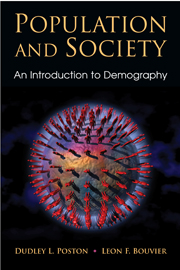Book contents
- Frontmatter
- Contents
- Preface
- Introduction
- 1 “We Are All Population Actors”: An Introduction to Demography
- 2 The Sources of Demographic Information
- 3 Fertility
- 4 Contraception and Birth Control
- 5 Mortality
- 6 Internal Migration
- 7 International Migration
- 8 Age and Sex Composition
- 9 World Population Change over Time
- 10 Population Change in the United States
- 11 Population Distribution
- 12 Cultural Adaptation and Growth
- 13 Population Policy
- 14 The Future of Planet Earth
- Glossary
- References
- Author Index
- Subject Index
Introduction
- Frontmatter
- Contents
- Preface
- Introduction
- 1 “We Are All Population Actors”: An Introduction to Demography
- 2 The Sources of Demographic Information
- 3 Fertility
- 4 Contraception and Birth Control
- 5 Mortality
- 6 Internal Migration
- 7 International Migration
- 8 Age and Sex Composition
- 9 World Population Change over Time
- 10 Population Change in the United States
- 11 Population Distribution
- 12 Cultural Adaptation and Growth
- 13 Population Policy
- 14 The Future of Planet Earth
- Glossary
- References
- Author Index
- Subject Index
Summary
The media these days are rediscovering population dynamics and the subject of demography. The first real heyday for demography was probably in the 1960s and 1970s with the “discovery” of the global population problem. In recent decades, demographic behavior and demographic characteristics have received increased attention in the popular media. As a result, the term demographics has seeped into our vocabulary. For us authors of this text, this is an encouraging sign. Forty years ago when we first began studying and teaching demography, the subject was nowhere near as recognized and discussed as it is today. Now, the importance of population change, whether in size, composition, or distribution, has become increasingly relevant in policymaking at the local, state, national, and international levels. There is an increasing awareness not only of population growth and decline but also of compositional change in age, sex, and racial identity.
Care must be taken, however, to evaluate the works of journalists and others who use demographic data and comment about their dynamics. It is very easy to make errors when reporting on and interpreting population behavior. Hopefully, readers of our book will become attuned to these types of errors that seem to appear every so often in the popular media.
Population and Society: An Introduction to Demography is intended for undergraduate students, as well as graduate students, taking their first course in demography.
- Type
- Chapter
- Information
- Population and SocietyAn Introduction to Demography, pp. 1 - 2Publisher: Cambridge University PressPrint publication year: 2010



